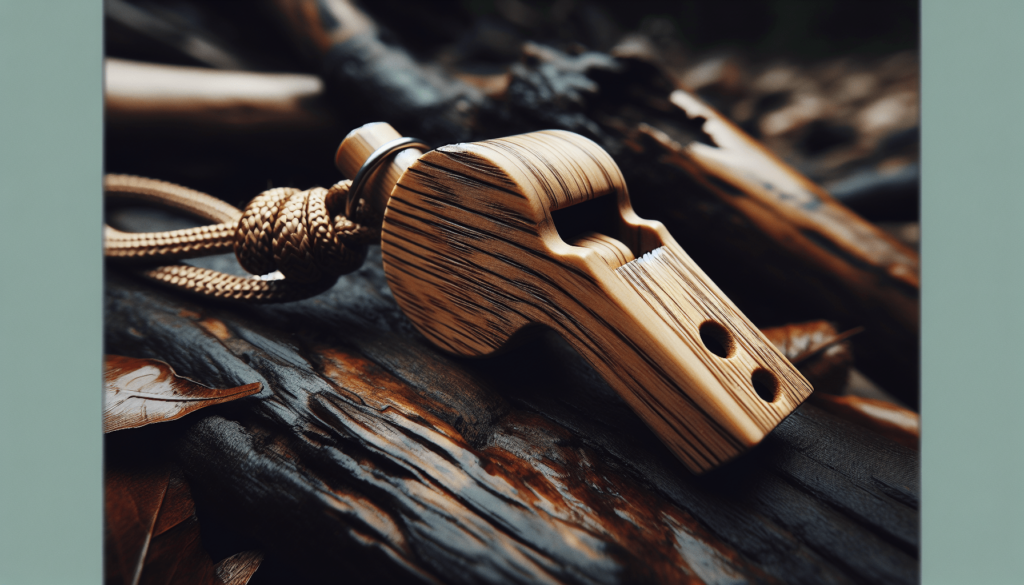You’re about to embark on the exciting journey of crafting your very own DIY survival whistle. This guide will walk you through the process step-by-step, ensuring you have a reliable tool for emergency situations. From gathering the necessary materials to perfecting the final product, you’ll find that creating a survival whistle is not only practical but also rewarding. Let’s jump right in and turn that ordinary piece of equipment into your lifeline in the wild! Have you ever found yourself wondering how you’d alert rescuers if you were lost in the wilderness? Creating a DIY survival whistle is not only an exciting project but also a potentially life-saving one. It’s an essential tool that every adventurer should have in their survival kit.
A whistle can travel further than your voice, making it one of the most effective tools for signaling for help. The sound of a whistle can cut through ambient noise like wind and water, making it easier for rescuers to locate you. Let’s dive in and explore how you can make your very own survival whistle!

Why You Need a Survival Whistle
A survival whistle might seem like a small addition to your gear, but it can be incredibly effective in emergency situations. It’s lightweight, easy to carry, and can make a loud noise to attract attention. When you’re in distress, every second counts, and having a reliable way to signal for help can make all the difference.
Benefits of a Survival Whistle
- Attention-Grabbing: The piercing sound of a whistle is hard to ignore and can be heard over long distances.
- Energy Efficient: Shouting uses up a lot of energy, while blowing a whistle requires less effort.
- Time-Saving: Using a whistle can quickly alert others to your location, speeding up rescue efforts.
- Versatility: A whistle can be used to signal different messages through various whistle patterns.
Important Features
When making your own survival whistle, you’ll want to ensure it meets certain criteria:
- Loudness: It should be able to emit a sound that can travel a long distance.
- Durability: It should withstand rough conditions and last long.
- Easy to Use: Adventurers of all ages and skill levels should be able to use it without difficulty.
Materials You Will Need
Creating a DIY survival whistle doesn’t have to be complex or expensive. Most of the materials you need might already be lying around your house.
List of Common Materials
Below are some items you may need:
| Material | Purpose |
|---|---|
| Plastic Tube | Main body of the whistle |
| Metal Tube | Durable alternative |
| Cork | For making the pea (optional) |
| Tape Measure | To measure tube lengths |
| Small saw or knife | To cut the tube |
| Sandpaper | To smooth edges |
| Marker | For marking measurements |
| Glue | To secure parts |
| Drill | For making holes |
Make sure to gather everything before diving into the project—it’ll make the process smoother and more enjoyable.
Types of DIY Survival Whistles
Before you start crafting, you’ll want to decide which type of whistle you’d like to make. There are several designs you could choose from, each with its own benefits and challenges.
The Classic Survival Whistle
This is the most common type of whistle, often used by hikers, campers, and people who engage in outdoor activities.
- Shape: Cylindrical
- Sound: High-pitched and loud
- Material: Often made from plastic or metal tubes
The Pealess Whistle
A pealess whistle is favored for its reliability since it doesn’t have any moving parts that can get stuck or frozen.
- Shape: Varies but generally compact
- Sound: Generally louder and can emit multiple pitches
- Material: Metal or high-strength plastic
The Paracord Whistle
A paracord whistle is integrated into a paracord bracelet, making it convenient to wear and carry.
- Shape: Integrated into a bracelet or keychain
- Sound: Not as loud but sufficient for short distances
- Material: Usually plastic
How to Make a DIY Survival Whistle
Now that you know the types of whistles and the benefits of having one, let’s get into the step-by-step process of making your very own survival whistle.
Preparing the Material
Step 1: Choosing the Tube
Select a suitable tube for your whistle. Plastic tubes are easy to work with, but metal tubes can be more durable.
- Plastic Tubes: Choose a tube with an inner diameter of roughly 10mm.
- Metal Tubes: A slightly smaller diameter is recommended as metal whistles can be more efficient in transmitting sound.
Step 2: Cutting the Tube
Cut the tube to your desired length. A standard length of about 5-7 cm works best for most whistles.
- Measure: Use your tape measure to measure the length.
- Cut: Carefully cut the tube using a small saw or knife.
Shaping the Whistle
Step 3: Making the Mouthpiece
Shape one end of the tube to form the mouthpiece. You can do this by beveling the edges.
- Mark: Use a marker to outline where you’ll bevel the edge.
- Sand: Smooth the edges with sandpaper.
Step 4: Creating the Sound Chamber
The sound chamber is crucial—it’s where the air gets split and produces the sound.
- Mark: Measure about 2 cm from the mouthpiece end and mark it.
- Cut: Create a notch at the mark. This will be the air exit point.
Assembling and Finalizing
Step 5: Adding the Pea (Optional)
If you want to add a “pea” to make the whistle trill, you can use a piece of cork.
- Cut: Cut a small piece of cork that fits snugly inside the tube.
- Insert: Push the cork piece into the tube, ensuring it can move slightly.
Step 6: Sealing and Testing
Seal any potential air leaks and test your whistle.
- Glue: Apply a small amount of glue around any seams.
- Test: Blow into the whistle to test its sound. Make adjustments if necessary.

Maintenance and Tips
Regular Maintenance
Even though DIY whistles are robust, they do require some maintenance to ensure they function correctly when you need them the most.
- Cleaning: Clean your whistle regularly, especially after use in dirty or wet conditions.
- Inspection: Check the whistle for any cracks or damages.
Usage Tips
- Blow in Short Bursts: This will not only save your breath but also make the sound carry further.
- Learn Morse Code: Basic Morse code can be signaled with your whistle for advanced communication.
Real-life Applications
The main benefit of DIY survival whistles is that they can be used in various real-life scenarios.
Hiking and Camping
You might get separated from your group. A loud whistle can help you reunite.
Boating
Noise from water and engines can make it hard for rescuers to hear you calling for help. A whistle can cut through that noise.
Emergencies
In urban settings, a whistle can help you alert others during personal safety situations.
Conclusion
Making a DIY survival whistle is a practical and rewarding endeavor. It’s a valuable tool that can make a big difference in emergency situations. Not only does it help you stay safe, but it also gives you a sense of self-reliance and preparedness.
So why not give it a try? Get your materials together and start creating your very own life-saving device. You never know when it might come in handy.

